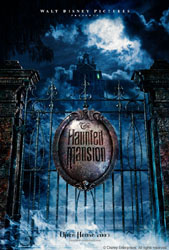
Cast * Story * Interesting Facts * The Ride

Cast * Story * Interesting Facts * The Ride
Directed by: : Rob Minkoff (Stuart Little, codirector
of The Lion King is in talks)
Written by: David Berenbaum
Music by: Mark Mancina
Production started on: January 7, 2003 in Los Angeles (pushed
back from November 15, 2002)
Release Date: November 26, 2003 (its original slot, from 11/7/03
which would have cannibalized Disney's own Brother
Bear)
Budget: $90 million
 |
 |
 |
Jim Evers... Eddie Murphy
Madame Leota... Jennifer Tilly
Ramsley, an evil butler... Terence Stamp
and Wallace Shawn, Marsha Thomason, Dina Waters, Aree Davis, Marc John
Jefferies
The groundskeeper of the Haunted Mansion... Don Knotts (character
cancelled)
 |
 |
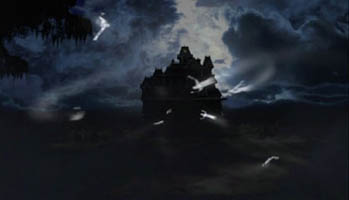 |
 |
Official Storyline
Jim Evers, a work-obsessed father who encounters a ghost while on a
job interview, when he and his wife and kids visit a haunted house: a cursed
New Orleans abode that houses 999 spirits aching to be set free. The vision
spooks him into a profound awareness of the importance of the family he
has previously neglected.
Spoiler-Filled Screenplay Review from Jim Hill Media (March 10, 2003)
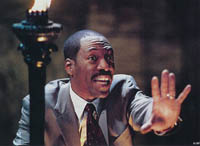 'MrTheFrog'
posted a review from the January 2002 version of Disney's
Haunted Mansion
screenplay. "I sat down to read this early version of the script expecting
to be scared, horrified, even terrified by how they were going to destroy
a classic. You'll be happy to know that I was very pleasantly surprised.
The film begins in the New Orleans town of Liberty. In a pristine old mansion,
a soon-to-be bride, sits in her room, penning a letter to her one true
love. Her dress sits on the bed beside her. As she finishes, she wipes
away the tears, rises, sprinkles some powder into a glass of wine, and
drinks from it. A moment later, the nobleman she was to marry, rushes into
the room to find her dead on the floor.
'MrTheFrog'
posted a review from the January 2002 version of Disney's
Haunted Mansion
screenplay. "I sat down to read this early version of the script expecting
to be scared, horrified, even terrified by how they were going to destroy
a classic. You'll be happy to know that I was very pleasantly surprised.
The film begins in the New Orleans town of Liberty. In a pristine old mansion,
a soon-to-be bride, sits in her room, penning a letter to her one true
love. Her dress sits on the bed beside her. As she finishes, she wipes
away the tears, rises, sprinkles some powder into a glass of wine, and
drinks from it. A moment later, the nobleman she was to marry, rushes into
the room to find her dead on the floor.
Jump ahead to the present. Eddie Murphy plays Jim Evers, a workaholic attorney. Obsessed with getting ahead, he has very little time for his wife Sara, or his two children Megan and Michael. He is in line for a huge promotion, but in order to seal the deal, he has to meet with the head of his company. And one thing the big boss is very fond of is the idea of 'family.' So in the interest of making a good impression, Jim drags his family, kicking and screaming, to meet him, in his big house, behind a big iron gate, on top of a big hill. And what is his name? Master Edward Gracey. Once inside, the members of the Evers family are trapped in the house, and separated from one another. Through a series of events Jim is lead to a séance room where he meets Madame Leota, a cryptic fortune teller whose head is inside a crystal ball, played by Jennifer Tilly. She tells him the tragic tale of the bride, and explains to him that he and his family are doomed to forever join the 999 happy haunts, unless they can set the bride free by the 13th hour.
Along the way, they meet an interesting (and familiar) cast of characters,
including:
- An old caretaker (played by Don Knotts), and his skin-n-bones dog.
- Phineas Pock: a plump ghost with a top hat
- Ezra: a tall thin skeletal ghost with a long coat and derby
- Gus: a short ghost with a long bushy beard, and a ball and chain
around his leg.
- And of course, Master Gracey."
'MrTheFrog' comments that even though changes might have been made to
the script since January 2002, "the writer David Berenbaum did a wonderful
job with this story, leaving no stone unturned. From the floating candelabra,
to the portraits with the wandering eyes, this is a writer who did his
homework, and he has an absolute masterpiece to show for it. This is THE
definitive Haunted Mansion movie. If this is done right, it could
possibly be the best live-action Disney film since Walt's time. I kid you
not. This has the potential to be a huge, HUGE hit for them. I think what
I liked so much is, this is not a kiddy movie. There are lots of parts
that are very intense, and disturbing. I have a hard time believing they'll
get a PG rating out of it (probably PG-13)."

![]() The actual Disney theme park ride claims to have "999 happy haunts", but
this film adaptation may have just the one (or at least, there's one central
ghost).
The actual Disney theme park ride claims to have "999 happy haunts", but
this film adaptation may have just the one (or at least, there's one central
ghost).
![]() The Haunted Mansion
is the only major attraction to appear in a different land in each Disney
Theme Park.
The Haunted Mansion
is the only major attraction to appear in a different land in each Disney
Theme Park.
![]() Rob Minkoff and
his production team were allowed to walk through the ride at Disneyland,
with all the lights on, for inspiration. "The big surprise was that in
the Madame Leota chamber, they said, 'Whatever you do, do not touch the
tablecloth.'" Why? "Because people, as they go through the ride, they spit.
They said, 'Be careful not to touch anything.'" So that's the scariest
secret of the Haunted Mansion? "Oops. I should have hesitated," Minkoff
said with a laugh. "It was terrifying. Parents will be keeping their kids
from it. 'You're not going on that ride!'"
Rob Minkoff and
his production team were allowed to walk through the ride at Disneyland,
with all the lights on, for inspiration. "The big surprise was that in
the Madame Leota chamber, they said, 'Whatever you do, do not touch the
tablecloth.'" Why? "Because people, as they go through the ride, they spit.
They said, 'Be careful not to touch anything.'" So that's the scariest
secret of the Haunted Mansion? "Oops. I should have hesitated," Minkoff
said with a laugh. "It was terrifying. Parents will be keeping their kids
from it. 'You're not going on that ride!'"
![]() An early Disneyland
Park concept featured a church on Main Street USA surrounded by a graveyard
leading up to a haunted house.
An early Disneyland
Park concept featured a church on Main Street USA surrounded by a graveyard
leading up to a haunted house.
![]() Given how well
the production of The Country Bears
seemed to be turning out by April 2001, Disney studio executives hurried
to put movie versions of other theme park favorites on the development
fast track and two new writers began work on a Haunted Mansion screenplay.
Given how well
the production of The Country Bears
seemed to be turning out by April 2001, Disney studio executives hurried
to put movie versions of other theme park favorites on the development
fast track and two new writers began work on a Haunted Mansion screenplay.
![]() Haunted House
(the movie's original title) was greenlit in early January 2002. Disney
hopes to turn the picture into a franchise. David Berenbaum, part of Disney's
writers-in-residence program, wrote the script.
Haunted House
(the movie's original title) was greenlit in early January 2002. Disney
hopes to turn the picture into a franchise. David Berenbaum, part of Disney's
writers-in-residence program, wrote the script.
![]() Eddie Murphy started
negotiating in March 2002 to star in Disney's feature. In addition to Murphy,
Disney has begun informal talks with Rob Minkoff (The
Lion King) to direct. Production is expected to start in November
2002. The movie is billed as a family scare-fest/comedy.
Eddie Murphy started
negotiating in March 2002 to star in Disney's feature. In addition to Murphy,
Disney has begun informal talks with Rob Minkoff (The
Lion King) to direct. Production is expected to start in November
2002. The movie is billed as a family scare-fest/comedy.
![]() Director Rob Minkoff
revealed in July 2002 that what’s done on the big screen with The Haunted
Mansion may in fact reflect in the famous 50 year old ride. "They have
a strategy at Disneyland that one of the things they have to do is bring
people back to the park,. [Changing staple rides is] the way they do it...
When they have an opportunity to do something new, to give it a little
bit of a reawakening, they're very excited. There are some of the images
from the ride that we are going to incorporate into the storytelling, but
really the goal is you'll watch this movie as its own thing. It's not about
a ride. What will happen is you'll see the movie, and you'll go, 'Oh, I
understand slightly differently what that meant [in the ride].' It will
actually have more of an inflection on the ride than the ride will have
an inflection on the movie… I've been going to Disneyland forever, and
I've been on that ride so many times. I always said to myself, 'Wouldn't
this make a cool movie?' When I got the call and they said, 'Do you want
to make a movie out of this?' it was suddenly like, 'God, I guess I have
to.'" The director also added that "There will be special effects but no
character animation so there will be a lot of ghost effects but no character
ghosts, not like Casper. I think there was some thought originally
that there might be."
Director Rob Minkoff
revealed in July 2002 that what’s done on the big screen with The Haunted
Mansion may in fact reflect in the famous 50 year old ride. "They have
a strategy at Disneyland that one of the things they have to do is bring
people back to the park,. [Changing staple rides is] the way they do it...
When they have an opportunity to do something new, to give it a little
bit of a reawakening, they're very excited. There are some of the images
from the ride that we are going to incorporate into the storytelling, but
really the goal is you'll watch this movie as its own thing. It's not about
a ride. What will happen is you'll see the movie, and you'll go, 'Oh, I
understand slightly differently what that meant [in the ride].' It will
actually have more of an inflection on the ride than the ride will have
an inflection on the movie… I've been going to Disneyland forever, and
I've been on that ride so many times. I always said to myself, 'Wouldn't
this make a cool movie?' When I got the call and they said, 'Do you want
to make a movie out of this?' it was suddenly like, 'God, I guess I have
to.'" The director also added that "There will be special effects but no
character animation so there will be a lot of ghost effects but no character
ghosts, not like Casper. I think there was some thought originally
that there might be."
![]() Jim Hill wrote
in August 2002 that "the buzz on the lot right now suggests that the start
of production on Mansion--which was originally supposed to get underway
in November--may now get pushed back, perhaps by as much as a year. Originally,
Disney’s Haunted Mansion movie was supposed to the studio’s big
release for October 2003 (just in time for Halloween). Nowadays… well,
the word is that Disney wants to first see how Pirates
does during the summer of 2003 before it agrees to plow another $100 million
or so into the production of another big effects picture that’s based on
a theme park ride. If Pirates of the Caribbean fails to pull in
a huge pile of box office gold next summer, you can bet that Disney’s Haunted
Mansion movie won't go forward as it was originally envisioned--as
a big budget major theatrical release. But even if the film does get postponed
(which given the commercial failure of producer Andrew Gunn's very own
The
Country Bears, director Rob Minkoff's Stuart Little II
and star Eddie Murphy's Pluto Nash, is looking more and more likely),
there is still a very strong possibility that this film will eventually
get made, perhaps in time for release for Halloween 2004." Fortnuately
or not, the project was indeed officially confirmed a month after this
article.
Jim Hill wrote
in August 2002 that "the buzz on the lot right now suggests that the start
of production on Mansion--which was originally supposed to get underway
in November--may now get pushed back, perhaps by as much as a year. Originally,
Disney’s Haunted Mansion movie was supposed to the studio’s big
release for October 2003 (just in time for Halloween). Nowadays… well,
the word is that Disney wants to first see how Pirates
does during the summer of 2003 before it agrees to plow another $100 million
or so into the production of another big effects picture that’s based on
a theme park ride. If Pirates of the Caribbean fails to pull in
a huge pile of box office gold next summer, you can bet that Disney’s Haunted
Mansion movie won't go forward as it was originally envisioned--as
a big budget major theatrical release. But even if the film does get postponed
(which given the commercial failure of producer Andrew Gunn's very own
The
Country Bears, director Rob Minkoff's Stuart Little II
and star Eddie Murphy's Pluto Nash, is looking more and more likely),
there is still a very strong possibility that this film will eventually
get made, perhaps in time for release for Halloween 2004." Fortnuately
or not, the project was indeed officially confirmed a month after this
article.
![]() An official teaser
website
featuring the movie's first poster opened on September 2002.
An official teaser
website
featuring the movie's first poster opened on September 2002.
![]() Jennifer Tilly's
involvement was announced in October 2002. It was revealed that same month
that Oscar-winning makeup designer Rick Baker would design some ghosties
as well as Madame Leota (Jennifer Tilly)'s crystal ball FX, and production
designer John Meyer was working on the film.
Jennifer Tilly's
involvement was announced in October 2002. It was revealed that same month
that Oscar-winning makeup designer Rick Baker would design some ghosties
as well as Madame Leota (Jennifer Tilly)'s crystal ball FX, and production
designer John Meyer was working on the film.
![]() Director Rob Minkoff
said a month before shooting started that he and the crew had already been
at work for nine months on pre-production. "We're having a lot of fun trying
to come up with a whole new way to see a ghost." He even examined some
of the thousands of ghost-sighting Web sites on the Internet for spooky
ideas. Speaking of the Disney theme partk attraction that inspired the
forthcoming comedy, "We're using some of the imagery of the ride--bits
and pieces woven in. But the movie has its own story, its own characters."
Director Rob Minkoff
said a month before shooting started that he and the crew had already been
at work for nine months on pre-production. "We're having a lot of fun trying
to come up with a whole new way to see a ghost." He even examined some
of the thousands of ghost-sighting Web sites on the Internet for spooky
ideas. Speaking of the Disney theme partk attraction that inspired the
forthcoming comedy, "We're using some of the imagery of the ride--bits
and pieces woven in. But the movie has its own story, its own characters."
![]() Marsha Thomason,
who plays Eddie Murphy's wife, revealed in a February 2003 interview that
the film would feature elements of the popular Disney theme-park ride on
which it is based. "We've got the singing heads. We've got the whole mausoleum.
We've got Madame Leota. Jennifer Tilly is playing Madame Leota. There's
a whole lot of the Disney ride in the movie. It's fab! We're having such
a good time. It's so much fun. [Eddie Murphy's] kids have been on the set,
and his wife."
Marsha Thomason,
who plays Eddie Murphy's wife, revealed in a February 2003 interview that
the film would feature elements of the popular Disney theme-park ride on
which it is based. "We've got the singing heads. We've got the whole mausoleum.
We've got Madame Leota. Jennifer Tilly is playing Madame Leota. There's
a whole lot of the Disney ride in the movie. It's fab! We're having such
a good time. It's so much fun. [Eddie Murphy's] kids have been on the set,
and his wife."
![]() Jennifer Tilly
talked about her role in a March 2003 chat with TV Guide: "When you go
into the ride [at Disney], there's a gypsy fortune teller's head in a crystal
ball, saying, 'Go back, Go back!' You know, Madame Leota. That's gonna
be me! I'm Eddie Murphy's sidekick in the movie. He carries my head around,
and I get bossy with him. I have lots of hair, I'm a smart ass, and I'm
very cryptic. I know all, I see all... If the movie's really successful,
Disney's gonna revamp the ride and I'll be the head in the ball at the
beginning of it! They're gonna totally update it."
Jennifer Tilly
talked about her role in a March 2003 chat with TV Guide: "When you go
into the ride [at Disney], there's a gypsy fortune teller's head in a crystal
ball, saying, 'Go back, Go back!' You know, Madame Leota. That's gonna
be me! I'm Eddie Murphy's sidekick in the movie. He carries my head around,
and I get bossy with him. I have lots of hair, I'm a smart ass, and I'm
very cryptic. I know all, I see all... If the movie's really successful,
Disney's gonna revamp the ride and I'll be the head in the ball at the
beginning of it! They're gonna totally update it."
![]() Buena Vista Motion
Pictures Group President Nina Jacobson said she was banking on the idea
that a big-budget offering such as Haunted Mansion, with its pricey
special effects and family star, Eddie Murphy, will reverse the perception
(created by Country Bears) that
films with theme-parks ties are lightweight attempts to capitalize on a
familiar piece of Disneyana.
Buena Vista Motion
Pictures Group President Nina Jacobson said she was banking on the idea
that a big-budget offering such as Haunted Mansion, with its pricey
special effects and family star, Eddie Murphy, will reverse the perception
(created by Country Bears) that
films with theme-parks ties are lightweight attempts to capitalize on a
familiar piece of Disneyana.
![]() Don Hahn revealed
in a March 2003 interview that the movie "draws on live-action and
animation] techniques. It is a live-action movie at its heart. It’ll be
a big special effects extravaganza. We’re just in the middle of it now--we
have about two more months of shooting."
Don Hahn revealed
in a March 2003 interview that the movie "draws on live-action and
animation] techniques. It is a live-action movie at its heart. It’ll be
a big special effects extravaganza. We’re just in the middle of it now--we
have about two more months of shooting."
![]() Director Rob Minkoff
said in July 2003 that the movie would be a straight-ahead ghost story,
unlike other recent haunted-house films. "I think the tone is going to
be different," he said in an interview at Comic-Con International in San
Diego. Such films as 13 Ghosts and The Haunting are "slightly
more like slasher movies than anything else. And I don't think that this
is. This is meant to be like a ghost story in the classic sense of it's
a story that you want to get involved in and interested in, and you can
relate to. So it's not just a guy's family comes and meets a lot of scary
ghosts in the house. Sometimes it's what you don't see that can be kind
of creepy."
Director Rob Minkoff
said in July 2003 that the movie would be a straight-ahead ghost story,
unlike other recent haunted-house films. "I think the tone is going to
be different," he said in an interview at Comic-Con International in San
Diego. Such films as 13 Ghosts and The Haunting are "slightly
more like slasher movies than anything else. And I don't think that this
is. This is meant to be like a ghost story in the classic sense of it's
a story that you want to get involved in and interested in, and you can
relate to. So it's not just a guy's family comes and meets a lot of scary
ghosts in the house. Sometimes it's what you don't see that can be kind
of creepy."
![]() Jennifer Tilly
was surprised to find her role as fortune-teller Madame Leota was a neck-up-only,
technically torturous affair. "They'd already shot my scenes with an empty
crystal ball," she explains. The plan was to then sandwich Tilly's close-ups
into existing shots. Getting a floaty, otherworldly effect, oddly enough,
required her to be extremely still. "They strapped me to a chair and actually
put my head in a vise because I move it around too much." Still, she didn't
mind terribly, since "it's the only movie I haven't had to lose weight
for."
Jennifer Tilly
was surprised to find her role as fortune-teller Madame Leota was a neck-up-only,
technically torturous affair. "They'd already shot my scenes with an empty
crystal ball," she explains. The plan was to then sandwich Tilly's close-ups
into existing shots. Getting a floaty, otherworldly effect, oddly enough,
required her to be extremely still. "They strapped me to a chair and actually
put my head in a vise because I move it around too much." Still, she didn't
mind terribly, since "it's the only movie I haven't had to lose weight
for."
![]() After the debacle
of Disney's The
Country Bears at the box office last year, director Rob Minkoff
admitted in August 2003 that "believe me, we're all breathing a sigh of
relief that Pirates
worked so well." Minkoff capped an 11-year career at Disney animation by
codirecting 1994's megahit The
Lion King, but left the studio to make the Stuart Little
pictures for Sony. He was invited back by Disney Studios chairman Dick
Cook, who had a script by neophyte writer David Berenbaum and a tentative
commitment from Eddie Murphy. Minkoff says the draft he first read "was
not quite right yet for Eddie, and a number of story things didn't add
up." Revisions were tailored specifically to Murphy, who plays a workaholic
real estate agent named Jim Evers. He promises his kids and his wife some
quality weekend time, but then the family gets waylaid at an estate, where
scores of spirits ultimately scare him into being a better dad.
After the debacle
of Disney's The
Country Bears at the box office last year, director Rob Minkoff
admitted in August 2003 that "believe me, we're all breathing a sigh of
relief that Pirates
worked so well." Minkoff capped an 11-year career at Disney animation by
codirecting 1994's megahit The
Lion King, but left the studio to make the Stuart Little
pictures for Sony. He was invited back by Disney Studios chairman Dick
Cook, who had a script by neophyte writer David Berenbaum and a tentative
commitment from Eddie Murphy. Minkoff says the draft he first read "was
not quite right yet for Eddie, and a number of story things didn't add
up." Revisions were tailored specifically to Murphy, who plays a workaholic
real estate agent named Jim Evers. He promises his kids and his wife some
quality weekend time, but then the family gets waylaid at an estate, where
scores of spirits ultimately scare him into being a better dad.
![]() One frightened
face you won't be seeing around the house is Don Knotts'. Minkoff, who's
fond of Knotts' 1966 opus The Ghost and Mr. Chicken, wanted him
for a cameo as a groundskeeper, but says "there wasn't enough for him to
do, according to his agent." The character was dropped.
One frightened
face you won't be seeing around the house is Don Knotts'. Minkoff, who's
fond of Knotts' 1966 opus The Ghost and Mr. Chicken, wanted him
for a cameo as a groundskeeper, but says "there wasn't enough for him to
do, according to his agent." The character was dropped.
 |
 |
 |
 |
Article taken from Doom
Buggies.
Looking Back in Time
The Haunted Mansion's history actually stretches back into the mid '50s, when Walt Disney asked conceptual artist and Imagineer Ken Anderson to start working on a walk-through "ghost house," as it was called in the early years of development, for his brand-new Disneyland theme park. In fact, the vaguest origins of the attraction stretch even further back to 1951, when Walt tapped artist Harper Goff for some conceptual designs for a haunted house to be placed in Disneyland.
Many of Goff's early designs suggest a building that might have come
from the storybook rural midwest, since one idea for the haunted house
was to build it on a crooked path just off of Disneyland's Main Street.
However, as Disneyland evolved through the '50s, the decision was made
to place the haunted house in the New Orleans Square section of the park,
which was still on the drawing boards. Because of this, once Anderson began
working on the project, the architectural design took a turn toward early
19th century southern plantation-style design.
 |
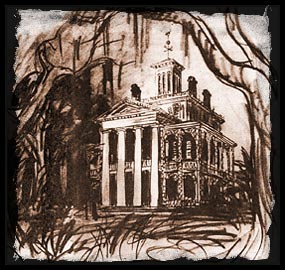 |
|
|
|
Different Ideas: A Look Into the Creative Process
One of Walt Disney's ideas for Ken Anderson's original walk-through spook house was to base the experience in New England (as the Haunted Mansion's facade at Walt Disney World is currently themed), and the storyline may have featured Ichabod Crane's fateful encounter with the Headless Horseman, as featured in the Disney film The Adventures of Ichabod and Mr. Toad. DoomBuggies.com has obtained a file written by Ken Anderson in October of 1957, describing the effects surrounding the climax of the attraction (a close encounter with the Horseman) and how they were to be accomplished. Interestingly, many of the Haunted Mansion's special effects utilized in the graveyard remain the same as Mr. Anderson envisioned them to this very day.
Construction and Development
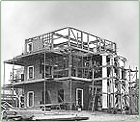 Ken
Anderson's Headless Horseman encounter was just one of many treatments
that he and other staffers proposed for the park's "Haunted House." He
also concocted a number of other concepts, all trying to tell a cohesive
tale. Meanwhile, the look of the attraction's facade was honed, and construction
was completed on Disneyland's "Haunted House" near the end of 1962.
Ken
Anderson's Headless Horseman encounter was just one of many treatments
that he and other staffers proposed for the park's "Haunted House." He
also concocted a number of other concepts, all trying to tell a cohesive
tale. Meanwhile, the look of the attraction's facade was honed, and construction
was completed on Disneyland's "Haunted House" near the end of 1962.
Meanwhile, Walt knew just who to assign to the difficult job of creating the magical effects for the ride. Yale Gracey, one of WED's brightest engineers, was put to work on the project, and despite the constant changes in concept, his visual effects were adopted into every storyline from the start of his tenure on the project
Rolly Crump’s Museum of the Weird
Rolly Crump, another WED visionary, worked closely with Gracey, forming a team that would devise most of the attraction's amazing illusions. In fact, as early as 1964, Crump was simultaneously developing gags for a related venture, known within WED as the "Museum of the Weird." In Walt's vision of the Haunted Mansion, the attraction would have two portions: the main body of the walk-through attraction, and a queue, or "spill area," at the entrance. This "spill area," which was also considered to be utilized as a themed restaurant (a la The Blue Bayou aside the Pirates of the Caribbean attraction), would be a showcase of curiosities supposedly discovered and unearthed from around the world. While Crump designed most of these concepts, Gracey took the lead in engineering the illusions, and Crump and Gracey's creations were to grace the walls of the "Museum of the Weird" as a pre-show to the Haunted Mansion.
Alas, with Walt's passing and more new ideas within WED regarding the Haunted Mansion, Crump's Museum was left on the drawing boards. However, some of the designs he created have been faintly echoed throughout the attraction as it was finally realized, and a few of his designs appear in the attraction just as he designed them to appear.
Yale Gracey’s Challenge: The Mystery of New Orleans
 Meanwhile,
Yale Gracey and Crump continued developing the illusions for the attraction.
Walt certainly didn't make Gracey's task simple. In an interview at the
time (when Walt was still referring to the future Mansion as the "New Orleans
exhibit,") Walt directed Gracey to create "something nice for the Hall
of the infamous part of the New Orleans exhibit... like werewolves, a Medusa,
marble busts that talk, even ordinary-appearing pictures that will change
into horrors before the visitors eyes." This was part of yet another plan
in which the Mansion might end up being part of a sprawling underground
walk-through exhibit that described the best and the worst of "nawlins."
Meanwhile,
Yale Gracey and Crump continued developing the illusions for the attraction.
Walt certainly didn't make Gracey's task simple. In an interview at the
time (when Walt was still referring to the future Mansion as the "New Orleans
exhibit,") Walt directed Gracey to create "something nice for the Hall
of the infamous part of the New Orleans exhibit... like werewolves, a Medusa,
marble busts that talk, even ordinary-appearing pictures that will change
into horrors before the visitors eyes." This was part of yet another plan
in which the Mansion might end up being part of a sprawling underground
walk-through exhibit that described the best and the worst of "nawlins."
Gracey's ghostly effect-tinkering was recalled recently by Crump. He
recalls working with Gracey in a huge room that WED had used for developing
the new spooky effects:
"Here is a great story about the Haunted Mansion effect "Imagineering" room. Yale had all his ghosts and magic strewn throughout this room. Once, we got a call from personnel saying that the janitors asked that we leave the lights on in there due to the creepiness of all the audioanimatronic ghosts and such. They complied, but put motion sensors in the room that would extinguish the lights and turn on all the ghost effects, when triggered. The next morning, they came in and found all the ghost effects still running and a broom lying in the center of the floor. Personnel called and said that the janitors would never be back."
Though this "New Orleans exhibit" was originally to include the
collection of imagined oddities and dark discoveries from the "Museum of
the Weird" project, many of the fully-realized effects and tricks conjured
up by Gracey and Crump went on to become the Haunted Mansion's showstopping
feats of "Illusioneering" (as Walt began to refer to the effects work.)
‘Imagineering’ the Finishing Touches
Once the Haunted Mansion's exterior facade was built at Disneyland to prepare the park's guests for the attraction yet to come, it stood there, unoccupied, for most of the decade. As the effects and storyline were continuing in development, the title "Haunted Mansion" hadn't yet been finalized. As a result, there are a few remnants of that era, such as this puzzle (pictured, left) which portrays Mickey Mouse and Goofy within a fully-developed scene of the attraction before the title was even decided upon. Paul Frees even began recording some trial dialogue tracks as the "Ghost Host" that refer to the attraction as the "Haunted House."
Marc Davis: Giving the Ghosts Some Character
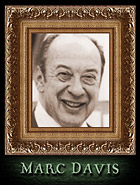 The
hard work WED was putting into the World's Fair attractions during the
60s was one of the factors keeping the Mansion from opening as originally
planned. Hence, the Disneyland show facade sat built yet unoccupied for
6 years... adding fuel to the fire of the public's anticipation for the
coming attraction.
The
hard work WED was putting into the World's Fair attractions during the
60s was one of the factors keeping the Mansion from opening as originally
planned. Hence, the Disneyland show facade sat built yet unoccupied for
6 years... adding fuel to the fire of the public's anticipation for the
coming attraction.
Walt Disney, always a definitive leader with a heady vision, passed
away in 1966. This became a crucial matter to the design team working on
the Haunted Mansion, for many reasons. For one, many of them were intimately
involved with Walt, and had a heavy emotional response to his passing.
But another clear threat to the project was that Walt had never made up
his mind about the premise of the attraction. At the time of Walt's death,
a script had been written with a definite dark tone for the proposed ride.
An excerpt follows:
"This is the lakeside estate of the unfortunate Blood family... Our house had a tragic and bloody history of unlucky owners who died sudden and violent deaths, which resulted in their unhappy ghosts remaining behind to fulfill the uncompleted missions of their lives. We started the work of restoration as soon as it arrived at Disneyland, but strangely enough, the work of each day was destroyed during the night. It mysteriously remains always night within the house... so we recommend you stay close together during your visit, and please, above all, obey your guide's instructions..."
This is clearly quite a distance from the eventual outcome, which
consists of "silly spooks" and "grim grinning ghosts." Though the technology
regarding the special effects evolved consistently from the beginning,
the show's divergent storyline was a source of great controversy among
the WED designers. WED legend Marc Davis, who created the iconic pixie
TInkerbell for Disney's version of Peter Pan, was one of the driving forces
carrying the show from creepy to kooky. Some samples of his conceptual
artwork for the Haunted Mansion can be seen to the left.
Davis, despite being brought into the Mansion project years after conceptual
work was already completed for the attraction, recalls that the design
process may have suffered from having too many cooks in the kitchen. In
Disneyland: Inside Story, author Randy Bright quotes Davis as he recalls
the confusion:
"Walt had not been gone that long. I think there were a lot of great ideas, but when you have too many people of equal clout, nobody's about to say, 'Hey, wait a minute! Let's do it this way,' which Walt would have done in a moment."
Bringing It All Together
Marc Davis' involvement with the project brought much-needed strong
visual character to the developing attraction. While working with other
artists at WED (such as Edward Kahn, who created the unused changing portrait
to the left of a man becoming a vegetable), Davis created some of the ride's
most enduring imagery and proved to be the perfect artist to bring a touch
of kooky light to the Mansion project. In his own words:
"Walt's attitude was (to give) experiences...a flash of this and a flash of that, everything within a subject matter. Rides... don't have a lot to do with continuity of story. It has to do with the entertainment value of surprise... seeing things you can't see anywhere else."
Toward August 9, 1969
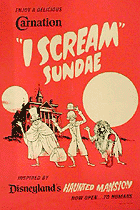 As
the opening date for the Haunted Mansion crept nearer, the WED Illusioneers
continued to hone and shape the storyline and presentation of the attraction.
Paul Frees, a popular Disneyland announcer and vocal talent (popularly
known as the voice of the Pillsbury Doughboy, Ludwig von Drake, and Boris
Badenov in the popular TV series The Adventures of Rocky and Bullwinkle),
was called upon to provide the voice of the unseen "Ghost Host." Before
the straightlaced, gleefully sardonic narration that exists today was settled
upon, Frees tried a few different accents on for size, and recorded a few
script variations (most written by Disney's great lyricist "X" Atencio)
as trial versions.
As
the opening date for the Haunted Mansion crept nearer, the WED Illusioneers
continued to hone and shape the storyline and presentation of the attraction.
Paul Frees, a popular Disneyland announcer and vocal talent (popularly
known as the voice of the Pillsbury Doughboy, Ludwig von Drake, and Boris
Badenov in the popular TV series The Adventures of Rocky and Bullwinkle),
was called upon to provide the voice of the unseen "Ghost Host." Before
the straightlaced, gleefully sardonic narration that exists today was settled
upon, Frees tried a few different accents on for size, and recorded a few
script variations (most written by Disney's great lyricist "X" Atencio)
as trial versions.
Atencio himself makes a guest appearance in the Haunted Mansion as the voice of the "tour interruption" host. Incidentally, he is the only recorded voice that you will ever hear referring to the ride vehicles as "Doom Buggies." Frees' Ghost Host merely refers to the ride vehicle as a "carriage... carrying you to the boundless realm of the supernatural."
The grand opening of the Haunted Mansion in August 1969 was heralded
by a promotional blitz, including a number of radio spots and tie-ins throughout
Disneyland, such as the "I Scream" Sundaes sold at Carnation Plaza (a poster
advertising these confections is pictured at left. Plastic spoons imprinted
with Mansion characters were also created for these special desserts).
|
||||||||||||